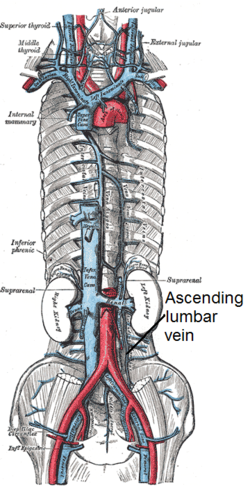Ascending lumbar vein
| Ascending lumbar vein | |
|---|---|
 The venae cavae and azygos veins with their tributaries. | |
| Details | |
| Drains from | Lateral sacral veins |
| Drains to | Azygos vein and hemiazygos vein |
| Identifiers | |
| Latin | vena lumbalis ascendens |
| TA98 | A12.3.07.011 A12.3.09.004 |
| TA2 | 4757, 4771 |
| FMA | 12858 |
| Anatomical terminology | |
The ascending lumbar vein is a vein that runs up through the lumbar region on the side of the vertebral column.
Structure
[edit]The ascending lumbar vein is a paired structure (i.e. one each for the right and left sides of the body). It starts at the common iliac veins.[1] It runs superiorly, intersecting with the lumbar veins as it crosses them.[1] It passes behind the psoas major muscle, but in front of the lumbar vertebrae.[1]
When the ascending lumbar vein crosses the subcostal vein, it becomes one of the following:
- the azygos vein (in the case of the right ascending lumbar vein).[1][2]
- the hemiazygos vein (in the case of the left ascending lumbar vein).[1]
- The first and second lumbar veins ends in the ascending lumbar vein(the third and fourth lumbar veins open into the posterior aspect of the inferior vena cava)
Clinical significance
[edit]Contrast medium may be injected into the ascending lumbar vein via the femoral vein in order to visualise the spinal canal.[3]
The ascending lumbar vein may be punctured during catheterisation.[4] This can cause bleeding into the dural space.[4]
References
[edit]- ^ a b c d e Chiva, Luis M.; Magrina, Javier (2018-01-01), Ramirez, Pedro T.; Frumovitz, Michael; Abu-Rustum, Nadeem R. (eds.), "Chapter 2 - Abdominal and Pelvic Anatomy", Principles of Gynecologic Oncology Surgery, Elsevier, pp. 3–49, doi:10.1016/b978-0-323-42878-1.00002-x, ISBN 978-0-323-42878-1, retrieved 2020-11-23
- ^ Roshan, John; Mears, Jennifer A.; Lachman, Nirusha; Christensen, Kevin; Ladewig, Dorothy J.; Asirvatham, Samuel J. (2011-01-01), Bredikis, Audrius J.; Wilber, David J. (eds.), "Chapter 17 - Role of Cryoablation for Superior Vena Cava Isolation and Ablation of Inappropriate Sinus Tachycardia", Cryoablation of Cardiac Arrhythmias, Saint Louis: W.B. Saunders, pp. 191–203, doi:10.1016/b978-1-4377-1615-3.00017-4, ISBN 978-1-4377-1615-3, retrieved 2020-11-23
- ^ Hawkes, C H; Roberts, G M (1984-01-01), Harrison, M. J. G. (ed.), "Chapter 60 - Lumbar canal stenosis", Contemporary Neurology, Butterworth-Heinemann, pp. 564–574, doi:10.1016/b978-0-407-00308-8.50064-1, ISBN 978-0-407-00308-8, S2CID 8133431, retrieved 2021-01-30
- ^ a b Harbert, Mary J.; Pardo, Andrea C. (2017-01-01), Swaiman, Kenneth F.; Ashwal, Stephen; Ferriero, Donna M.; Schor, Nina F. (eds.), "21 - Neonatal Nervous System Trauma", Swaiman's Pediatric Neurology (Sixth Edition), Elsevier, pp. 156–160, doi:10.1016/b978-0-323-37101-8.00021-7, ISBN 978-0-323-37101-8, retrieved 2021-01-30
External links
[edit]- thoraxlesson5 at The Anatomy Lesson by Wesley Norman (Georgetown University) (postmediastinumlevel5)
- figures/chapter_29/29-4.HTM: Basic Human Anatomy at Dartmouth Medical School
